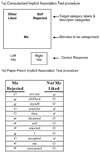Training implicit social anxiety associations: an experimental intervention
- PMID: 20102788
- PMCID: PMC2838945
- DOI: 10.1016/j.janxdis.2010.01.001
Training implicit social anxiety associations: an experimental intervention
Abstract
The current study investigates an experimental anxiety reduction intervention among a highly socially anxious sample (N=108; n=36 per Condition; 80 women). Using a conditioning paradigm, our goal was to modify implicit social anxiety associations to directly test the premise from cognitive models that biased cognitive processing may be causally related to anxious responding. Participants were trained to preferentially process non-threatening information through repeated pairings of self-relevant stimuli and faces indicating positive social feedback. As expected, participants in this positive training condition (relative to our two control conditions) displayed less negative implicit associations following training, and were more likely to complete an impromptu speech (though they did not report less anxiety during the speech). These findings offer partial support for cognitive models and indicate that implicit associations are not only correlated with social anxiety, they may be causally related to anxiety reduction as well.
(c) 2010 Elsevier Ltd. All rights reserved.
Figures



Similar articles
-
The effect of a single-session attention modification program on response to a public-speaking challenge in socially anxious individuals.J Abnorm Psychol. 2008 Nov;117(4):860-868. doi: 10.1037/a0013445. J Abnorm Psychol. 2008. PMID: 19025232 Free PMC article. Clinical Trial.
-
Fear of evaluation in social anxiety: mediation of attentional bias to human faces.J Behav Ther Exp Psychiatry. 2014 Dec;45(4):475-83. doi: 10.1016/j.jbtep.2014.06.007. Epub 2014 Jul 5. J Behav Ther Exp Psychiatry. 2014. PMID: 25039035
-
Assessing attentional biases with stuttering.Int J Lang Commun Disord. 2016 Jan;51(1):84-94. doi: 10.1111/1460-6984.12187. Epub 2015 Jul 14. Int J Lang Commun Disord. 2016. PMID: 26176777
-
Hyperscanning and avoidance in social anxiety disorder: the visual scanpath during public speaking.Psychiatry Res. 2015 Feb 28;225(3):667-72. doi: 10.1016/j.psychres.2014.11.025. Epub 2014 Nov 24. Psychiatry Res. 2015. PMID: 25530414
-
Threatening faces and social anxiety: a literature review.Clin Psychol Rev. 2010 Aug;30(6):669-90. doi: 10.1016/j.cpr.2010.05.001. Epub 2010 May 21. Clin Psychol Rev. 2010. PMID: 20554362 Review.
Cited by
-
Applying the Quadruple Process model to evaluate change in implicit attitudinal responses during therapy for panic disorder.Behav Res Ther. 2014 Jan;52:17-25. doi: 10.1016/j.brat.2013.10.009. Epub 2013 Nov 10. Behav Res Ther. 2014. PMID: 24275066 Free PMC article.
-
Reducing stigma toward seeking mental health treatment among adolescents.Stigma Res Action. 2011;1(2):9-21. Stigma Res Action. 2011. PMID: 24286023 Free PMC article.
-
Cognitive bias modification versus CBT in reducing adolescent social anxiety: a randomized controlled trial.PLoS One. 2013 May 14;8(5):e64355. doi: 10.1371/journal.pone.0064355. Print 2013. PLoS One. 2013. PMID: 23691203 Free PMC article. Clinical Trial.
-
Implicit associations in social anxiety disorder: the effects of comorbid depression.J Anxiety Disord. 2014 Aug;28(6):537-46. doi: 10.1016/j.janxdis.2014.05.008. Epub 2014 Jun 14. J Anxiety Disord. 2014. PMID: 24983794 Free PMC article.
-
Sex, status, competition, and exclusion: Intraminority stress from within the gay community and gay and bisexual men's mental health.J Pers Soc Psychol. 2020 Sep;119(3):713-740. doi: 10.1037/pspp0000282. Epub 2020 Jan 13. J Pers Soc Psychol. 2020. PMID: 31928026 Free PMC article.
References
-
- American Psychiatric Association. Diagnostic and Statistical Manual of Mental Disorders. 4th ed. Washington, DC: American Psychiatric Association; 1994.
-
- Asendorpf JB, Banse R, Mucke D. Double dissociation between implicit and explicit personality self-concept: The case of shy behavior. Journal of Personality and Social Psychology. 2002;83:380–393. - PubMed
-
- Baccus JR, Baldwin MW, Packer DJ. Increasing implicit self-esteem through classical conditioning. Psychological Science. 2004;15:498–502. - PubMed
Publication types
MeSH terms
Grants and funding
LinkOut - more resources
Full Text Sources
Medical
Research Materials

